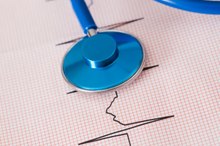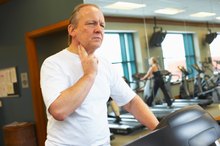What does fact checked mean?
At Healthfully, we strive to deliver objective content that is accurate and up-to-date. Our team periodically reviews articles in order to ensure content quality. The sources cited below consist of evidence from peer-reviewed journals, prominent medical organizations, academic associations, and government data.
The information contained on this site is for informational purposes only, and should not be used as a substitute for the advice of a professional health care provider. Please check with the appropriate physician regarding health questions and concerns. Although we strive to deliver accurate and up-to-date information, no guarantee to that effect is made.
What Happens to the Blood Oxygen Level When a Human Exercises?
Your muscles require up to 100 times the blood flow during exercise than they need at rest, according to Dr. Michael Joyner, one of the principal investigators at Mayo Clinic’s Center for Translation Sciences and Activities. This increased blood flow helps limit the effect exercise has on blood oxygen levels. When your body tissues need more oxygen than they can get, whether during exercise or at rest, you enter a state of hypoxia.
Blood Oxygen Saturation
A device known as a pulse oximeter measures the saturation of oxygen in your blood. The measurement taken using a pulse oximeter shows an estimation of your blood oxygen levels. Normal blood oxygen levels provide pulse oximeter readings between 95 and 100 percent. If your pulse oximeter reading drops below 90 percent, you have low blood oxygen levels known as hypoxemia 1. Hypoxemia eventually causes your tissues to experience an oxygen deficiency, known as hypoxia 1.
- A device known as a pulse oximeter measures the saturation of oxygen in your blood.
Cardiovascular Response to Exercise
How the Heart & Lungs Work During Exercise
Learn More
Exercise places your body in a state of increased need for oxygen. To meet these needs your cardiovascular system increases its cardiac output by increasing the amount of blood pumped out of the heart with each heartbeat and by increasing the number of times your heart beats each minute. The two mechanisms that allow more blood to flow out of the heart with each heartbeat include dilation of the arterioles within your skeletal muscles and stronger contractions of the ventricles of your heart. As your heart beats faster, blood flows faster through your lungs and the amount of time oxygen has to enter the blood stream decreases, making it harder for your blood to stay oxygenated. While the oxygen level of your blood stays relatively the same sue to this process, your muscles cannot access all of this oxygen and must begin relying on anaerobic processes to continue functioning if exercise continues.
- Exercise places your body in a state of increased need for oxygen.
- While the oxygen level of your blood stays relatively the same sue to this process, your muscles cannot access all of this oxygen and must begin relying on anaerobic processes to continue functioning if exercise continues.
Maintaining Blood Oxygen Levels
Anaerobic processes used within your muscles decreases the pH level of your blood due to the production of lactic acid. The more lactic acid in your blood, the lower the pH. As the pH drops, chemoreceptors responsible for controlling how fast you breathe become stimulated and your respiratory rate increases. This increased respiratory rate helps keep your blood oxygenated to the required levels.
- Anaerobic processes used within your muscles decreases the pH level of your blood due to the production of lactic acid.
- The more lactic acid in your blood, the lower the pH.
- As the pH drops, chemoreceptors responsible for controlling how fast you breathe become stimulated and your respiratory rate increases.
Hypoxia
Why Would a Physically Fit Person's Heart Rate Return to Normal Faster Than an Unfit Person's?
Learn More
If continue to exercise to the point that increased cardiac output and increased respirations fail to keep your tissues and blood oxygenated, hypoxemia and hypoxia occur and your performance decreases 1. Stop exercising if you experience extreme shortness of breath, lightheadedness, chest pain, decreased coordination or dizziness. These symptoms indicate a problem with your heart or decreased levels of oxygen reaching your brain.
Related Articles
References
- MayoClinic.com: Hypoxemia
- Physiology of Sport and Exercise; Jack H. Wilmore, et al.
- Kent BD, Mitchell PD, Mcnicholas WT. Hypoxemia in patients with COPD: cause, effects, and disease progression. Int J Chron Obstruct Pulmon Dis. 2011;6:199-208. doi:10.2147/COPD.S10611
- Cleveland Clinic. Hypoxemia. Updated March 7, 2018.
- Dodd J, Getov S, Jones P. Cognitive function in COPD. European Respiratory Journal. 2010;35(4):913-922. doi:10.1183/09031936.00125109
- Ebner, F., Ullén, S., Åneman, A. et al. Associations between partial pressure of oxygen and neurological outcome in out-of-hospital cardiac arrest patients: an explorative analysis of a randomized trial. Crit Care 2019;23(1):30. doi:10.1186/s13054-019-2322-z
- Duke T, Peel D, Graham S, Howie S, Enarson PM, Jacobson R. Oxygen concentrators: a practical guide for clinicians and technicians in developing countries. Ann Trop Paediatr. 2010;30(2):87-101.
- Tiep B, Carter R, Zachariah F, et al. Oxygen for end-of-life lung cancer care: managing dyspnea and hypoxemia. Expert Rev Respir Med. 2013;7(5):479-90.
- Sarkar M, Niranjan N, Banyal PK. Mechanisms of hypoxemia. Lung India. 2017;34(1):47-60. doi:10.4103/0970-2113.197116
- Majumdar SR, Eurich DT, Gamble JM, Senthilselvan A, Marrie TJ. Oxygen saturations less than 92% are associated with major adverse events in outpatients with pneumonia: a population-based cohort study. Clin Infect Dis. 2011;52(3):325-31. doi:10.1093/cid/ciq076
- Dorsch JJ, Wickwire EM. OSA/COPD overlap: convergence on a theme? J Clin Sleep Med. 2019;15(1):9-10. doi:10.5664/jcsm.7556
- Cleveland Clinic. Hypoxemia: prevention. Updated March 7, 2018.
Writer Bio
Kimberly Wonderly has a Bachelor of Science degree in exercise science and has worked as a personal trainer for six years. Wonderly has also taken many child development classes, while running a daycare out of her home for three years. She wrote for the "Rocket" at Slippery Rock University for two years while attending college.









